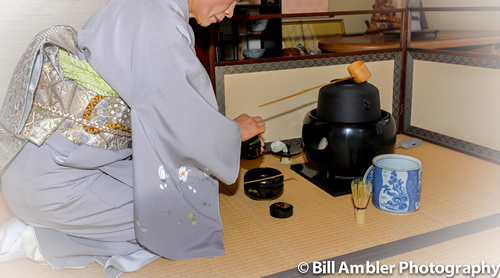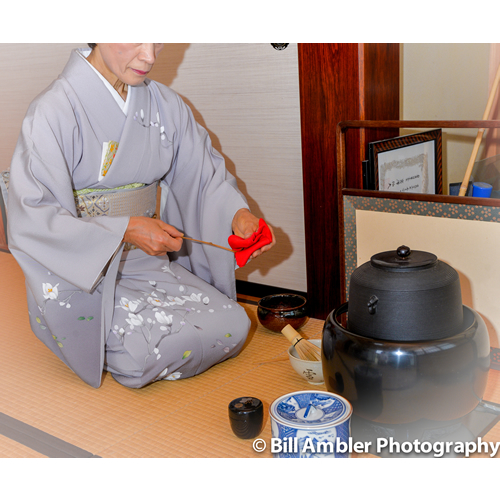Posted by TOKYO MATCHA SELECTION - Foreign staff (He is living in Japan) on 3rd Jun 2017

In a previous article about green tea and matcha, I made a necessarily compact reference to the Japanese tea ceremony and its place in Japanese culture, and it has bothered me since then that I didn't have sufficient space to qualify my assertion. I wrote: "...few Japanese people ever participate in the tea ceremony, though the philosophy behind it is appreciated by all."
Of course, there's an element of hyperbole to that statement; how can I, as a foreigner, say what might or might not be truly appreciated by all Japanese? Yet, it is the impression I've gathered over the years; at the very least, my Japanese friends and acquaintances accept the tea ceremony as an important part of their culture, whether they've experienced it or not. However, the allusion to a philosophy behind the tea ceremony may be as difficult for Japanese people to explain, as it is for outsiders to grasp.
Finding a Teishu
Fortunately, much has already been written on the complexities of the tea ceremony, both in print and on internet sites such as this one. All these sources can give outsiders a valuable insight into the types of tea ceremony performed, the equipment and procedures used, and the correct etiquette that kyaku (客) - guests - should observe, etc. But I wanted to get a better picture of the significance of the tea ceremony to a teishu (亭主) - a practitioner and teacher of the tea ceremony.
If the common term for the practice of the tea ceremony is chado (茶道) - the way of tea - what does that way entail in the mind of the teishu? Clearly, there are historical links between Zen Buddhism and chado, and the more formal or ceremonial chaji (茶事) style employed in kaiseki (懐石) banqueting; so is there a spiritual as well as cultural aspect to the tea ceremony?
To try and answer these questions and others, I made the trip to Yamanashi prefecture to ask my good friend, Tetsuko-san, for her thoughts.
Tetsuko-san

Tetsuko-san, like so many elderly Japanese women, is very spry, with seemingly boundless reserves of energy and a deep appreciation of nature. Being a gentleman, I would never presume to ask her age, but I know she's been practicing and performing the tea ceremony since she was a young girl. She's also been closely involved in the cultivation and harvesting of green tea her entire married life.
Actually, I'd imagined my trip to Tetsuko-san's home would simply be a fact-finding venture, but when I arrived, I found she'd gone to great lengths to prepare a demonstration, just for me, of the tea ceremony. She wore kimono, and, being a genuinely sweet and generous person, had even borrowed some items of equipment she lacked at home. Between my questions and her detailed explanations, a performance that would normally last about 15 minutes, went on for closer to 2 hours! I hope to revisit some of my impressions of the experience in part 2 of this article.
Becoming a licensed teishu like Tetsuko-san can take anything from 10-20 years, depending on the individual, and involves some considerable expense in tuition and registration fees, not to mention the high cost of equipment, utensils and appropriate ceramics. Naturally, for my first question, I asked her why she'd embarked on such a costly and difficult path.
Love
Perhaps I was anticipating a pat answer - that she was, in her own way, trying to keep the chado tradition alive - but I should have known better; Tetsuko-san would never be that glib!
Her reply was actually quite simple; she loves green tea. I'm not sure love is quite the right word, at least not in the same sense as when I say I love Dutch coffee, or I love French cuisine, but it makes perfect sense to me in describing Tetsuko-san's deep affinity with green tea.
In my earlier article (quoted from above), I suggested that growing, tending and harvesting green tea was a labour of love. Certainly it requires hard work, patience and dedication. But more than that, it binds the grower to the cycles of nature and the seasons in a very spiritual way. Thus, green tea is both the life blood of Tetsuko-san's beliefs, and the glue that has held her family together, so the tea ceremony is, at least in part, an expression of that love.
The Beginning
Now, I may again be guilty of hyperbole when writing about Tetsuko-san's love of green tea, but no more than she herself may have used in answering my questions - it's often said that the Japanese have a tendency to express themselves in rather vague terms! Be that as it may, Tetsuko-san was not at all vague when recollecting the more pragmatic reasons she had for taking up the tea ceremony in the first place.
The truth is, very few females of Tetsuko-san's generation were ever expected to have careers; for them, an education was more a preparation for married life, wherein skills for receiving and entertaining guests could be important in finding a husband. For Tetsuko-san as a young woman, those skills encompassed three main disciplines essential to Japanese hospitality: washoku (和食), or culinary arts; traditional aesthetics; and the tea ceremony, which itself is as much about aesthetics as it is about tasting tea.
In part two of this article, I'll look a little more closely at the spiritual thinking and traditional aesthetics embodied in the ideals of miyabi (雅) and wabi-sabi (侘寂), and how they apply in Tetsuko-san's way of tea.